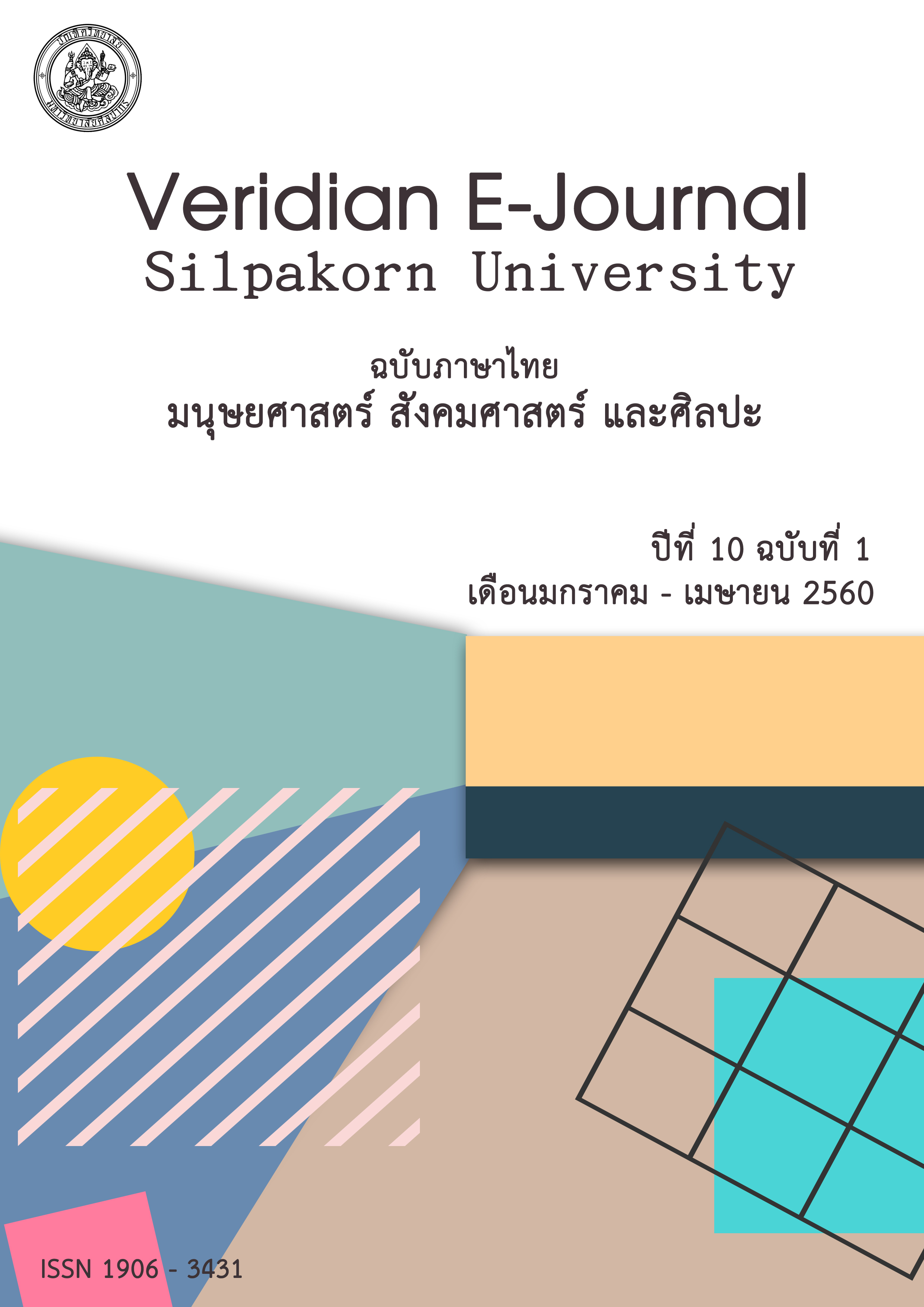แนวทางการจัดการศึกษาต่อเนื่องในสถาบันอุดมศึกษาในประเทศไทย
Main Article Content
Abstract
การวิจัยแนวทางการจัดการศึกษาต่อเนื่องในสถาบันอุดมศึกษาในประเทศไทยเป็นการวิจัยและพัฒนาโดยใช้การวิจัยแบบผสม (Mixed Method) มีวัตถุประสงค์ 1) เพื่อสังเคราะห์รูปแบบในการจัดการศึกษาต่อเนื่องของสถาบันอุดมศึกษา 2) เพื่อสำรวจสภาพและความต้องการในการศึกษาต่อเนื่องของบุคคลวัยผู้ใหญ่ที่อยู่นอกระบบการศึกษา 3) เพื่อเสนอแนวทางที่เหมาะสมในการจัดการศึกษาต่อเนื่องสำหรับสถาบันอุดมศึกษา เก็บข้อมูลเชิงปริมาณด้วยแบบสอบถามและข้อมูลเชิงคุณภาพด้วยการสัมภาษณ์และการเสวนากลุ่ม เลือกประขากรและกลุ่มตัวอย่างแบบเฉพาะเจาะจง ได้แก่ กลุ่มที่ 1 ผู้เกี่ยวข้องกับการจัดการศึกษาในมหาวิทยาลัยศิลปากร ประกอบด้วยผู้บริหาร อาจารย์ บุคคลากรทางการศึกษา ผู้เชี่ยวชาญ และผู้เกี่ยวข้องในการจัดการศึกษาของมหาวิทยาลัยศิลปากร จำนวน 10 คน กลุ่มที่ 2 ได้แก่ บุคคลวัยผู้ใหญ่ในเครือข่ายการศึกษานอกระบบโรงเรียนและการศึกษาตามอัธยาศัยทั่วประเทศ ใน 9 ภูมิภาค จังหวัดละ 50 คน ครอบคลุม 5 อาชีพ รวมทั้งหมด 450 คน วิเคราะห์ข้อมูลเชิงปริมาณด้วยสถิติเบื้องต้น ได้แก่ ความถี่ ร้อยละ ค่าเฉลี่ย และส่วนเบี่ยงเบนมาตรฐาน แบบสอบถามเป็นแบบมาตราส่วนประเมินค่า (Rating Scale) 5 ระดับ วิเคราะห์ข้อมูลเชิงคุณภาพด้วยการวิเคราะห์เนื้อหา
ผลการวิจัยพบว่า 1. การจัดการศึกษาต่อเนื่องของสถาบันอุดมศึกษาในประเทศไทยประกอบด้วยองค์ประกอบหลัก 3 ส่วน คือ 1) ปัจจัยที่เป็นสภาวะที่เอื้อเกื้อหนุน ค้ำจุน เปิดโอกาส เป็นองค์ประกอบร่วมหรือเป็นเงื่อนไขอย่างใดอย่างหนึ่งที่จะทำให้การจัดการศึกษาต่อเนื่องของสถาบันอุดมศึกษาในประเทศไทยเกิดมีขึ้น ดำเนินอยู่ และพัฒนาต่อไป ) กระบวนการในการจัดการศึกษา ประกอบด้วยการพัฒนาระบบการบริการทางวิชาการและสื่อสนับสนุนการเรียนรู้การกำหนด/การรับกลุ่มเป้าหมายของการศึกษา การจัดการเรียนการสอนและการประเมินผลการจัดการศึกษาและ 3) ผลผลิตของการจัดการศึกษา ได้แก่ ผู้สำเร็จการศึกษาตามหลักสูตรระดับต่าง ๆ และการฝึกอบรม งานวิจัยและพัฒนาอันเกี่ยวเนื่องมาจากการดำเนินงานตามแผนยุทธศาสตร์ และการประสานความร่วมมือกับหน่วยงาน องค์กรภายนอกและระบบการบริหาร ผลการศึกษาด้านการศึกษาต่อเนื่องของสถาบันอุดมศึกษาต่างประเทศพบว่ามีการดำเนินงานตามสภาพการจัดการศึกษาของแต่ละประเทศที่สอดคล้องกับกลุ่มเป้าหมาย นโยบาย หลักสูตร คุณลักษณะผู้สอน การจัดการเรียนการสอน และสื่อสนับสนุนการสอน 2. สภาพและความต้องการในการศึกษาต่อเนื่องของบุคคลวัยผู้ใหญ่ที่อยู่นอกระบบการศึกษา พบว่า ต้องการศึกษาต่อเนื่องในโครงการของมหาวิทยาลัยที่จัดขึ้นเพื่อบุคคลภายนอก มีวัตถุประสงค์ในการเรียนรู้เพื่อประกอบอาชีพ ค่าใช้จ่ายในการศึกษาต่อเนื่องที่ต้องการคือต่ำกว่า 1,000 บาท ต้องการได้ประกาศนียบัตร ให้จัดชั้นเรียนในวันเสาร์อาทิตย์ ระยะเวลา 1 – 2 สัปดาห์ ครั้งละ 3 ชั่วโมง สถานที่จัดการเรียนการสอน แหล่งเรียนรู้และเครือข่ายการเรียนรู้คือ ศึกษาในชุมชน จัดการเรียนการสอนโดยการศึกษาดูงาน ฝึกประสบการณ์ตรง คุณสมบัติและลักษณะผู้สอนที่ต้องการ คือ มีความเข้าใจ ยอมรับผู้อื่นและมีความรู้ความสามารถ ต้องการให้ผู้เรียนมีส่วนร่วมในกระบวนการ สื่อ และอุปกรณ์การเรียนการสอนคือ ได้ฝึกปฏิบัติของจริง วัดและประเมินผลโดยการทดสอบความรู้ความเข้าใจ และต้องการการสนับสนุนช่วยเหลือด้านทุนบางส่วน 3. แนวทางที่เหมาะสมในการจัดการศึกษาต่อเนื่องสำหรับสถาบันอุดมศึกษาควรมีการปฏิบัติการในภาพรวมอย่างเป็นระบบ ครอบคลุมและสอดรับกับกลุ่มเป้าหมาย นโยบาย หลักสูตร คุณลักษณะผู้สอน การจัดการเรียนการสอน สื่อสนับสนุนการสอน และปัจจัยเกี่ยวข้องซึ่งมีลักษณะเฉพาะตามสภาพของแต่ละสถาบัน ทั้งนี้ควรมีความเชื่อมโยงการเป็นเครือข่ายทั้งภายในและภายนอกที่คำนึงถึงวิถีชีวิต และสอดรับกับบริบทของสังคม เศรษฐกิจการเมือง และสิ่งแวดล้อม
The research of organizing continuing education in higher education institution in Thailand is a research and development in mixed method aiming to 1.) synthesize the format of organizing continuing education in higher education institution 2) survey the conditions and needs of adult outside the higher education system for continuing education 3) propose appropriate solutions for organizing continuing education in higher education institution. The research tools are questionnaire, interview, group discussion and data collection. The quantitative and qualitative data analyses are conducted on organizing adult education and the continuing education in higher education institution in Thailand and abroad. The samples are divided into 2 groups. The first group is administrators and teachers, educational staff, the experts and people involve in ongoing education in higher education institution, being specifically selected by qualification criteria as a Known group. The second group are 400 adults in the network of non-formal education and informal education all over the country. Sample randomization was performed according to region and occupational groups by simple randomizing method. By region, 9 sample groups in 8 regions are used for analysis aiming to set the guideline for organizing continuing education in higher education institution. The results show that
1. Organizing for continuing education in higher education institution in Thailand consists of 3 main parts that are 1) The factors that contributing, supporting, giving opportunity, or being a mutual part or being any conditions leading to organization of the continuing education in higher education institution in Thailand to be operated and further developed.
2. Process of organizing education is composed of the development of academic service systems and learning support materials: setting and selecting the target group, organizing learning and learning evaluation: outputs of organizing education are graduates from various courses and training: research and development according to strategic plan and collaboration with external organizations and management systems. For continuing education in abroad higher education institution, they are operated following their own educational organization of each country, corresponding to the target group, policy, curriculum, instructor’s character, teaching and learning organization and teaching-support materials.
3. The conditions and need for organizing continuing education for adults outside the education system. It is found that there are an interest and demand for organizing continuing education program for general public people, the details are, an interest to join the continuing education program arranged for the outsiders by the university, the objective of learning for profession, the cost for continuing education per one course is under 1000 baht, the requirement of course graduation with certificates, the content of profession is the most interesting , days and time requested for organizing classes on weekends, most interested in learning within 1-2 weeks ,demand on learning hour is 3 hours. The most convenient location for organizing learning is in a community area, the most interested teaching method is a study trip, learning resources and learning networks being the most interested is to study in their community education institution. The most interested qualifications and characteristics of instructor is to understand and accept others being knowledgeable and having good skills. Process of teaching activities which in most demand is student thinking participations. Teaching media and equipment selected is practical learning. The most measurement and evaluation requirement is measurement of knowledge and understanding. They needed a scholarship support or partial financial accommodation. The appropriate guideline for overall organizing continuing education in higher education institution should be operated systematically and in line with the group target, policy, courses, instructor’s character, teaching and learning organization, teaching-support material and the others related to each particular institution that link with inside and outside network, in line with life styles and conform with social, economic and political contexts.
